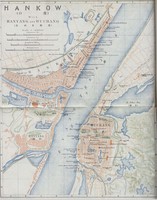 Hankow 1915
Hankow 1915 This map of the tri-city area of Hankow, Wuchang, and Hanyang was published in 1915 by the compilers of "An Official Guide to East Asia, Volume IV" by the Imperial Japanese Government Railways . This map serves a translational function. A scale is included for Japanese, Chinese, English, and metric measurements. The cities, rivers, and lakes are given names in multiple languages; several of the buildings are also named in multiple languages. While it was published in Tokyo and many of the smaller labels are in English, it appears that the map could be functional for multiple groups of people. The use of a letter and number grid system indicates that the map could be used to gain a sense of the general location of certain buildings or places. For example, the Hanyang Arsenal is in block C7, while the Japanese Concession is in G2; this allows for a sense of relational distance. In the Hankow section, each building on the bund is listed along with major street names. Each concession is clearly labeled and delineated by light dashed lines. Although less heavily labeled, Wuchang’s streets and a few key buildings are also marked. Key buildings, such as colleges and factories, are marked by a darker shade of pink throughout the map.
A key element of this map is color and line-work. The cities are marked by filled in pink shapes, the water by blue radiating lines, hills by green hatches, city walls by green lines with consistent perpendicular marks, and railroads by black lines. There is an emphasis on water: the blue is the largest block of color; not only is the major river named but many of the lakes and tributaries are named; and careful attention is given to details of shore lines. City borders are second most prominent division, after the division of land and water. Hankow appears neat and order. While the foreign concessions are outside the original city wall, their borders follow line of this city wall, and the railroad and edge of the city is roughly parallel to the shoreline of the river meeting the city. This neat, contained, and ordered shape of Hankow is further emphasized by the placement of the text “Hankow” which also follows on the same parallel line as the rail line and edge of the city. Lastly, the foreign concessions appear to be set up in a grid system, and even the Chinese section despite curving roads appears also to be in a rough grid system. Hanyang and Wuchang appear slightly less ordered, although both are contained in a city wall like Hankow. Both Wuchang and Hanyang run up to the hills, marked by green hatches, some of these green hills coming into the city itself. The use of pink and the way in which sections are marked in each of the cities tends to flatten the city; some streets may be hilly but one would not know from this map. The shape of the land is indicated by the hills marked on the edge of the map, and the shorelines of lakes and rivers.
In conclusion, the map appears to represent a sort of finished project, a successful treaty port. The layout of the cities, especially Hankow, appears neat and ordered. There is not only evidence of a lot of business and industry, but of culture and entertainment as indicated by the labeling of the race track, golf club, colleges, temples, and cemeteries. It appears to be a welcoming area, one that is navigable due to the clear separation of the three cities by the water, the grid or near-grid system in Hankow, and the helpful letter and number gridding on this map.
Represents a sense of accomplishment – a sort of finished product of a successful treaty port – highlights business and industry, neat controlled, no harsh lines by ethnicity, detailed (dense in a nice way). Lastly the use of multiple languages on this map, not only helps multiple groups of people use it, but implies that multilingualism and translations are present in the cities themselves.
 Residential Map of Hankou town, Hubei
Residential Map of Hankou town, Hubei This map, titled Hubei Hankou zhen jiedao tu (湖北汉口镇街道圖), is attributed to Fang Sikan and is dated 1877 (Text in the upper left corner beside the title). The map is woodblock print on a 63 x 165cm sheet, with a scale of 1:5,000 and is oriented with the north in the upper right corner (Library of Congress).
The map centers its focus on Hankou almost exclusively, depicting the city within the bounds of the wall, the large Houhu lake to the northwest (後湖), and the meeting rivers (the Hanshui and Yangtze) to the south. Interestingly, the river dubbed Hanshui (漢水) in other maps is here called xianghe (襄河). Furthermore, the way the map is presented frames the river, forming Hankou’s natural southern border, as continuous, while in reality (and in following with the map’s labeling) it meets the Yangtze just after the island (labeled only as “lumber yard here” [此處板廠 ?]). The lake to the North, Houhu, is also oddly placed, with the Houhu in modern maps appearing far further north, with another river cutting between it and Hankou
The wall is depicted very prominently, with its corresponding gates all being labeled and drawn in detail. A number of buildings have been selected for more specific portrayal as well, particularly those along Main Street (zhengjie, 正街?). While this map lacks a formal distinction between the Chinese city and the English Concession, they are made clearly distinguishable by the artist’s attention to architectural style. The European style buildings along Hualou road are joined with a church and horse race track, along with labeled English businesses and the consulate in the far bottom right.
By constructing Hankou as a continuous whole, contained within the exterior wall and located in relation to natural markers like the river and Houhu lake, Fang Sikan (and other potential contributors) assert the unity of the city despite the creation of the English concession in 1862. The map maker’s attention to street names, landmark buildings, and potentially interesting sites like the race track and the Lou Meeting Hall (絡與會館), convey accessibility and potentially frame the city as inviting for tourists and merchants.
 Kodachrome Photograph during Japanese Air Raid on Hankou
Kodachrome Photograph during Japanese Air Raid on Hankou
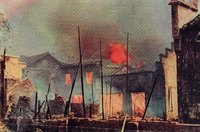 Kodachrome photograph of Japanese Air Raid on Hankou
Kodachrome photograph of Japanese Air Raid on Hankou
 Japanese Air Raid on Hankou Kodachrome photograph.
Japanese Air Raid on Hankou Kodachrome photograph.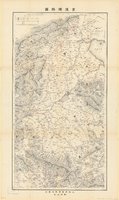 Jinghan Railway Map [京漢鐵路圖]
Jinghan Railway Map [京漢鐵路圖]
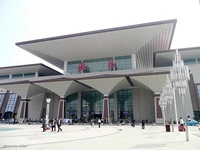 Wuchang Railway Station Image Source: China Train Guide website
Wuchang Railway Station Image Source: China Train Guide website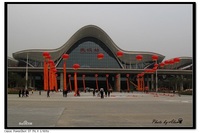 Wuhan Railway Station Image Source: China Train Guide website
Wuhan Railway Station Image Source: China Train Guide website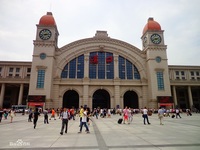 Close-up of Current Hankou Railroad Station Image Source: China Train Guide website https://www.chinatrainguide.com/wuchang-railway-station/
Close-up of Current Hankou Railroad Station Image Source: China Train Guide website https://www.chinatrainguide.com/wuchang-railway-station/ Current Hankou Railroad Station
Current Hankou Railroad Station
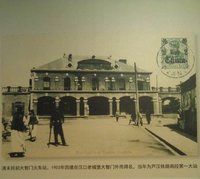 The Railway Station Hankow
The Railway Station Hankow
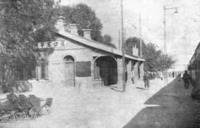 Yudaimen Station
Yudaimen Station
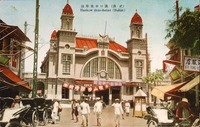 A Postcard of Hankow Station from 1927
A Postcard of Hankow Station from 1927
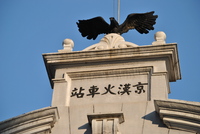 The eagle on Hankou Dazhimen Railway Station 2
The eagle on Hankou Dazhimen Railway Station 2
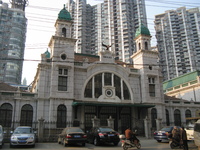 The disused Hankou Dazhimen Station - the original terminal of the Beijing to Hankou Railway
The disused Hankou Dazhimen Station - the original terminal of the Beijing to Hankou Railway
 Hankow 1915 This map of the tri-city area of Hankow, Wuchang, and Hanyang was published in 1915 by the compilers of "An Official Guide to East Asia, Volume IV" by the Imperial Japanese Government Railways . This map serves a translational function. A scale is included for Japanese, Chinese, English, and metric measurements. The cities, rivers, and lakes are given names in multiple languages; several of the buildings are also named in multiple languages. While it was published in Tokyo and many of the smaller labels are in English, it appears that the map could be functional for multiple groups of people. The use of a letter and number grid system indicates that the map could be used to gain a sense of the general location of certain buildings or places. For example, the Hanyang Arsenal is in block C7, while the Japanese Concession is in G2; this allows for a sense of relational distance. In the Hankow section, each building on the bund is listed along with major street names. Each concession is clearly labeled and delineated by light dashed lines. Although less heavily labeled, Wuchang’s streets and a few key buildings are also marked. Key buildings, such as colleges and factories, are marked by a darker shade of pink throughout the map. A key element of this map is color and line-work. The cities are marked by filled in pink shapes, the water by blue radiating lines, hills by green hatches, city walls by green lines with consistent perpendicular marks, and railroads by black lines. There is an emphasis on water: the blue is the largest block of color; not only is the major river named but many of the lakes and tributaries are named; and careful attention is given to details of shore lines. City borders are second most prominent division, after the division of land and water. Hankow appears neat and order. While the foreign concessions are outside the original city wall, their borders follow line of this city wall, and the railroad and edge of the city is roughly parallel to the shoreline of the river meeting the city. This neat, contained, and ordered shape of Hankow is further emphasized by the placement of the text “Hankow” which also follows on the same parallel line as the rail line and edge of the city. Lastly, the foreign concessions appear to be set up in a grid system, and even the Chinese section despite curving roads appears also to be in a rough grid system. Hanyang and Wuchang appear slightly less ordered, although both are contained in a city wall like Hankow. Both Wuchang and Hanyang run up to the hills, marked by green hatches, some of these green hills coming into the city itself. The use of pink and the way in which sections are marked in each of the cities tends to flatten the city; some streets may be hilly but one would not know from this map. The shape of the land is indicated by the hills marked on the edge of the map, and the shorelines of lakes and rivers. In conclusion, the map appears to represent a sort of finished project, a successful treaty port. The layout of the cities, especially Hankow, appears neat and ordered. There is not only evidence of a lot of business and industry, but of culture and entertainment as indicated by the labeling of the race track, golf club, colleges, temples, and cemeteries. It appears to be a welcoming area, one that is navigable due to the clear separation of the three cities by the water, the grid or near-grid system in Hankow, and the helpful letter and number gridding on this map. Represents a sense of accomplishment – a sort of finished product of a successful treaty port – highlights business and industry, neat controlled, no harsh lines by ethnicity, detailed (dense in a nice way). Lastly the use of multiple languages on this map, not only helps multiple groups of people use it, but implies that multilingualism and translations are present in the cities themselves.
Hankow 1915 This map of the tri-city area of Hankow, Wuchang, and Hanyang was published in 1915 by the compilers of "An Official Guide to East Asia, Volume IV" by the Imperial Japanese Government Railways . This map serves a translational function. A scale is included for Japanese, Chinese, English, and metric measurements. The cities, rivers, and lakes are given names in multiple languages; several of the buildings are also named in multiple languages. While it was published in Tokyo and many of the smaller labels are in English, it appears that the map could be functional for multiple groups of people. The use of a letter and number grid system indicates that the map could be used to gain a sense of the general location of certain buildings or places. For example, the Hanyang Arsenal is in block C7, while the Japanese Concession is in G2; this allows for a sense of relational distance. In the Hankow section, each building on the bund is listed along with major street names. Each concession is clearly labeled and delineated by light dashed lines. Although less heavily labeled, Wuchang’s streets and a few key buildings are also marked. Key buildings, such as colleges and factories, are marked by a darker shade of pink throughout the map. A key element of this map is color and line-work. The cities are marked by filled in pink shapes, the water by blue radiating lines, hills by green hatches, city walls by green lines with consistent perpendicular marks, and railroads by black lines. There is an emphasis on water: the blue is the largest block of color; not only is the major river named but many of the lakes and tributaries are named; and careful attention is given to details of shore lines. City borders are second most prominent division, after the division of land and water. Hankow appears neat and order. While the foreign concessions are outside the original city wall, their borders follow line of this city wall, and the railroad and edge of the city is roughly parallel to the shoreline of the river meeting the city. This neat, contained, and ordered shape of Hankow is further emphasized by the placement of the text “Hankow” which also follows on the same parallel line as the rail line and edge of the city. Lastly, the foreign concessions appear to be set up in a grid system, and even the Chinese section despite curving roads appears also to be in a rough grid system. Hanyang and Wuchang appear slightly less ordered, although both are contained in a city wall like Hankow. Both Wuchang and Hanyang run up to the hills, marked by green hatches, some of these green hills coming into the city itself. The use of pink and the way in which sections are marked in each of the cities tends to flatten the city; some streets may be hilly but one would not know from this map. The shape of the land is indicated by the hills marked on the edge of the map, and the shorelines of lakes and rivers. In conclusion, the map appears to represent a sort of finished project, a successful treaty port. The layout of the cities, especially Hankow, appears neat and ordered. There is not only evidence of a lot of business and industry, but of culture and entertainment as indicated by the labeling of the race track, golf club, colleges, temples, and cemeteries. It appears to be a welcoming area, one that is navigable due to the clear separation of the three cities by the water, the grid or near-grid system in Hankow, and the helpful letter and number gridding on this map. Represents a sense of accomplishment – a sort of finished product of a successful treaty port – highlights business and industry, neat controlled, no harsh lines by ethnicity, detailed (dense in a nice way). Lastly the use of multiple languages on this map, not only helps multiple groups of people use it, but implies that multilingualism and translations are present in the cities themselves.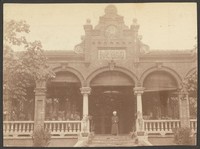 Hankow. Old Kuan I Ch'iao Mosque Site Guang yi qiao Mosque (old), Hankou, Hubei Sheng, China
Hankow. Old Kuan I Ch'iao Mosque Site Guang yi qiao Mosque (old), Hankou, Hubei Sheng, China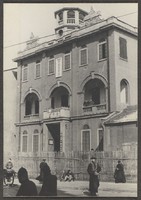 Hankow. New Kuan | Ch'iao Mosque
Hankow. New Kuan | Ch'iao Mosque
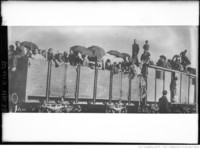 Chinese Revolution, inhabitants of Hankou [Hankou] fleeing rebels to Beijing [by train]
Chinese Revolution, inhabitants of Hankou [Hankou] fleeing rebels to Beijing [by train]
 The Bombing of Hankow Newsreel Newreel footage
The Bombing of Hankow Newsreel Newreel footage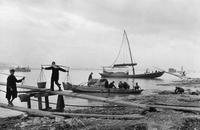 Fishing ships in Hankow
Fishing ships in Hankow
 Japanese Bombing of Hankow Postcard
Japanese Bombing of Hankow Postcard
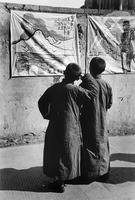 boys looking at images celebrating Japanese defeat
boys looking at images celebrating Japanese defeat
 Scenes in French Concession of Hankow during the Japanese advance Newsreel footage
Scenes in French Concession of Hankow during the Japanese advance Newsreel footage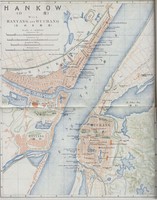 Tri-City 1915 Map
Tri-City 1915 Map
 Residential Map of Hankou town, Hubei This map, titled Hubei Hankou zhen jiedao tu (湖北汉口镇街道圖), is attributed to Fang Sikan and is dated 1877 (Text in the upper left corner beside the title). The map is woodblock print on a 63 x 165cm sheet, with a scale of 1:5,000 and is oriented with the north in the upper right corner (Library of Congress). The map centers its focus on Hankou almost exclusively, depicting the city within the bounds of the wall, the large Houhu lake to the northwest (後湖), and the meeting rivers (the Hanshui and Yangtze) to the south. Interestingly, the river dubbed Hanshui (漢水) in other maps is here called xianghe (襄河). Furthermore, the way the map is presented frames the river, forming Hankou’s natural southern border, as continuous, while in reality (and in following with the map’s labeling) it meets the Yangtze just after the island (labeled only as “lumber yard here” [此處板廠 ?]). The lake to the North, Houhu, is also oddly placed, with the Houhu in modern maps appearing far further north, with another river cutting between it and Hankou The wall is depicted very prominently, with its corresponding gates all being labeled and drawn in detail. A number of buildings have been selected for more specific portrayal as well, particularly those along Main Street (zhengjie, 正街?). While this map lacks a formal distinction between the Chinese city and the English Concession, they are made clearly distinguishable by the artist’s attention to architectural style. The European style buildings along Hualou road are joined with a church and horse race track, along with labeled English businesses and the consulate in the far bottom right. By constructing Hankou as a continuous whole, contained within the exterior wall and located in relation to natural markers like the river and Houhu lake, Fang Sikan (and other potential contributors) assert the unity of the city despite the creation of the English concession in 1862. The map maker’s attention to street names, landmark buildings, and potentially interesting sites like the race track and the Lou Meeting Hall (絡與會館), convey accessibility and potentially frame the city as inviting for tourists and merchants.
Residential Map of Hankou town, Hubei This map, titled Hubei Hankou zhen jiedao tu (湖北汉口镇街道圖), is attributed to Fang Sikan and is dated 1877 (Text in the upper left corner beside the title). The map is woodblock print on a 63 x 165cm sheet, with a scale of 1:5,000 and is oriented with the north in the upper right corner (Library of Congress). The map centers its focus on Hankou almost exclusively, depicting the city within the bounds of the wall, the large Houhu lake to the northwest (後湖), and the meeting rivers (the Hanshui and Yangtze) to the south. Interestingly, the river dubbed Hanshui (漢水) in other maps is here called xianghe (襄河). Furthermore, the way the map is presented frames the river, forming Hankou’s natural southern border, as continuous, while in reality (and in following with the map’s labeling) it meets the Yangtze just after the island (labeled only as “lumber yard here” [此處板廠 ?]). The lake to the North, Houhu, is also oddly placed, with the Houhu in modern maps appearing far further north, with another river cutting between it and Hankou The wall is depicted very prominently, with its corresponding gates all being labeled and drawn in detail. A number of buildings have been selected for more specific portrayal as well, particularly those along Main Street (zhengjie, 正街?). While this map lacks a formal distinction between the Chinese city and the English Concession, they are made clearly distinguishable by the artist’s attention to architectural style. The European style buildings along Hualou road are joined with a church and horse race track, along with labeled English businesses and the consulate in the far bottom right. By constructing Hankou as a continuous whole, contained within the exterior wall and located in relation to natural markers like the river and Houhu lake, Fang Sikan (and other potential contributors) assert the unity of the city despite the creation of the English concession in 1862. The map maker’s attention to street names, landmark buildings, and potentially interesting sites like the race track and the Lou Meeting Hall (絡與會館), convey accessibility and potentially frame the city as inviting for tourists and merchants. Hankow, Bolshevik propaganda photo showing the entrance to Hankou under a triumphal arch of Jacob Bordin
Hankow, Bolshevik propaganda photo showing the entrance to Hankou under a triumphal arch of Jacob Bordin